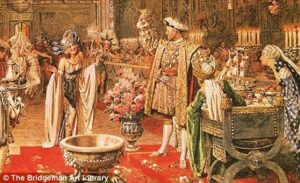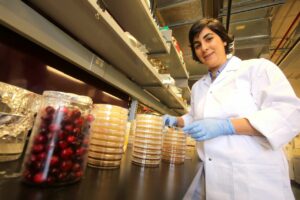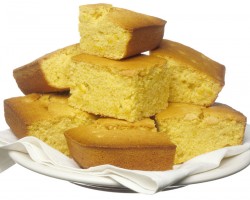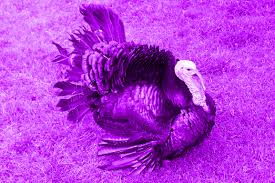
Weird Facts You Never Knew About Your Thanksgiving Dinner
Thanksgiving is filled with traditions passed down from generation to generation…And also with oddities. Here are four fun ones we enjoyed reading.

1) Sweet Potatoes Were Henry VIII’s Favorite Aphrodisiac
 Many foods have been considered aphrodisiacs, but sweet potatoes were more famous than most for “procuring bodily lust.” Their powers are mentioned by no less a poet than Shakespeare, who writes in The Merry Wives of Windsor, “Let the sky rain potatoes; let it thunder to the tune of ‘Green Sleeves’; hail kissing-comfits and snow eringoes; let there come a tempest of provocation, I shelter me here.” Today they’re a staple of upscale burger joints, but at the time they were a new food from an exotic land, introduced into a culture hungering for sweetness. We know that Henry VIII liked sweet potatoes, and probably would have had them either boiled with prunes or made into what we would now consider to be a spiced sweet potato pie.
Many foods have been considered aphrodisiacs, but sweet potatoes were more famous than most for “procuring bodily lust.” Their powers are mentioned by no less a poet than Shakespeare, who writes in The Merry Wives of Windsor, “Let the sky rain potatoes; let it thunder to the tune of ‘Green Sleeves’; hail kissing-comfits and snow eringoes; let there come a tempest of provocation, I shelter me here.” Today they’re a staple of upscale burger joints, but at the time they were a new food from an exotic land, introduced into a culture hungering for sweetness. We know that Henry VIII liked sweet potatoes, and probably would have had them either boiled with prunes or made into what we would now consider to be a spiced sweet potato pie.

2) Cranberries Can Prevent the Formation of Bacterial Biofilms
 Cranberry juice is famous for helping people fight urinary tract infections. If you’ve ever had one, there’s a 90% chance it was caused by the celebrity bacteria, E. coli, as that is what’s responsible for nine out of ten of what scientists tactfully refer to as “community-acquired UTIs.” Cranberry juice helps, but only recently have scientists figured out exactly how it helps.
Cranberry juice is famous for helping people fight urinary tract infections. If you’ve ever had one, there’s a 90% chance it was caused by the celebrity bacteria, E. coli, as that is what’s responsible for nine out of ten of what scientists tactfully refer to as “community-acquired UTIs.” Cranberry juice helps, but only recently have scientists figured out exactly how it helps.
Since it would be unethical to infect people with E. coli, or leave them untreated if they were already infected, scientists restricted themselves to collecting the urine from uninfected people. Some of those people were asked to drink a lot of water, and some were asked to drink cranberry juice. When exposed to urine filled with cranberry juice, the E. coli bacteria suddenly became less able to stick to each other or anything else. This loss of adhesion meant they couldn’t get together and form biofilms, slick sheets of bacteria that foster further growth. Cranberries don’t kill bacteria directly, but they do run bacterial social clubs out of town.

3) Cornbread Used to Be Made With Ashes
 Cornbread has become progressively less sad over the years. While it was always a staple food, it was rarely made by people who actually wanted to eat it. The earliest cornbreads were just corn mush, water and salt that was baked in the ashes of the fire.
Cornbread has become progressively less sad over the years. While it was always a staple food, it was rarely made by people who actually wanted to eat it. The earliest cornbreads were just corn mush, water and salt that was baked in the ashes of the fire.
Then the ashes started to do something. Ashes from the fire were often saved and boiled with potassium salts. The resulting white mixture could be made into soap or other cleaning agents. Cooks found that, when they were making sourdough, they could cut the sour taste by adding a little “potash” to the bread. Then they found that the bread made with potash rose more quickly.
Up until then, the only way to make bread rise was to add some yeast. Even cakes were yeast-based. Anything that didn’t rise with yeast didn’t rise at all. Potash was a quick way to fix that. By the 1800s, cooks all over America were turning into chemists, mixing potash and acids in their cornbread to make it rise. The risen dough had a bitter taste, so they added sweeteners. Cornbread stopped being what you ate when you couldn’t get anything else and became more of a treat. Eventually, homemade potash was replaced by commercially-made baking soda, giving us the slightly sweet, fluffy cornbread we eat today.

4) Turkey Makes Urine Turn Purple
 Purple urine isn’t great, but to be fair to turkey, it might be seen more as a useful diagnostic tool than a problem. Purple urine is a sign that a person has a bacterial infection.
Purple urine isn’t great, but to be fair to turkey, it might be seen more as a useful diagnostic tool than a problem. Purple urine is a sign that a person has a bacterial infection.
It starts with tryptophan, which is found in turkey. The chemical does no harm, and as it goes through the digestive system is naturally broken down into indoxyl sulfate. If it has to go stay in the digestive system for a while, bacteria get at it and further break it down into indoxyl. Bacteria can turn urine alkaline. In an alkaline environment, the indoxyl turns into indirubin and indigo. When the urine comes out, especially if it comes out of a patient in a hospital who is catheterized, it can turn green, blue, or sometimes a deep purple. The condition has come to be known as Purple Urine Bag Syndrome. That’s one way to enliven Thanksgiving.
-Excerpt from Esther Inglis-Arkell’s top 10 list for io9.com






